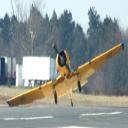Yahoo Answers is shutting down on May 4th, 2021 (Eastern Time) and beginning April 20th, 2021 (Eastern Time) the Yahoo Answers website will be in read-only mode. There will be no changes to other Yahoo properties or services, or your Yahoo account. You can find more information about the Yahoo Answers shutdown and how to download your data on this help page.
Trending News
WWII photo reconnaissance: why Spitfires?
This week's "Nova" episode on PBS, "3D Spies of WWII", explored allied aerial photo reconnaissance over occupied Europe. The program credited the Spitfire as the aerial platform.
I know that other aircraft were used in photo reconnaissance flights. But, for the life of me, I can't figure out why they might have used Spitfires at all. Yes, it was a wonderful fighter, but fighter maneuverability works against it as a photography platform. The early Spitfires also lacked endurance.
Seems to me that for aerial photo reconnaissance during war, you want a long-range, stable platform with some self-defense capability, and maybe speed to flee if that seems the better course. Those requirements suggest that you convert medium and heavy bombers, like DeHavilland Mosquitos or B-17s. (The Mosquito *was* produced in a photo reconnaissance version.)
To my question, then: Why convert a home defense fighter like a Spitfire, badly needed for home defense, to a reconnaissance role? What unique value would a Spitfire bring to that mission?
Added 19-JAN: Thanks for the answers, so far. I'm now realizing that there are (at least) two distinctly different roles for photo reconnaissance in war: Large area map making, where the pilot would fly back and forth in long swaths at high altitude, and tactical "spot" photography, which might be at high or low altitude, and has a fast turn-around requirement to produce actionable intelligence.
The longer range bombers would work in the map making role, but the converted Spitfires would excel at the quick in-and-out tactical missions.
(Now that Wikipedia is back, I can also see that the Mosquito was fast, but not quite as fast as the Spitfire, and had a good service ceiling, though a bit lower than the Spit. But it wasn't available early in the war. Later on, it was an effective photo reconnaissance plane.)
Additional edit, 19-JAN: I wish I could give more than one best answer... but thanks a bunch to everyone.
It seems clear that the Spitfire was the best choice for bringing back the pilot and his film at the time. Yes, there was a high price to pulling a thousand of the best Allied air-superiority fighters off of the air-to-air mission for photo reconniassance; a price justified by the value of the intelligence they brought back.
My candidate aircraft, the fast and stealthy DeHavilland Mosquito, did not become operational until later in the war. It took still longer before it proved itself in deep penetration missions. Had it been available earlier, its greater range might have made it the first choice for photo reconnissance.
15 Answers
- Max CruiseLv 79 years agoFavorite Answer
Excellent question unlike so much here on Yahoo! Answers.
Here is what I think since I am unable to cite chapter and verse.
The Spitfire was fast, something we can all agree on. Remove all the guns, ammo, ammo trays, and armor. Now you have a very fast aircraft. Also the Spitfire is small and is hard to see in the air.
The light weight helps increase the range. Speed is life. Just about all recon aircraft were unarmed, including the Mosquito. One point I wish to mention, the Mosquito was never armed with any self defense weapons.
The USAAF use the P-38 Lightening for recon work. Again, armor and armament were removed to provide more performance.
Came across the article in the link below. States some of the Spits were armed. Also it states the short range Spitfire were able to fly all the way to Berlin due to the ability to carry extra fuel. About 1,000 Spitfires were used in the recon role.
Good Question.
- 9 years ago
The biggest reason was for morale.
Spitfires were available, and they had many different development "hacks" that weren't quite what the Squadrons wanted but were very useful for specific roles, say at a certain altitudes, loading and ATTITUDE.
Ask any person what they wanted to be in over hostile territory in that time in the RAF, RCAF or even the USAF (the USA flew these also but I'm not sure if in Photo-Recon versions); they wanted the meanest bird in the air with the best safety record.
Of course, the early birds were prone to various problems that would lead to in-flight disasters on some repeated long trips if the maintainance wasn't perfect but this wasn't known untill later. Oddly enough as innitially designed it would have done better, but production expediencies lead to a weak fuselage former in the rear of the ship that lead to several early crashes due to a very localized flutter induced high amplitude flexing and failure (sometimes refered to as crystalization). Later, even when these formes were rather crudely reinforced by forging they would SOMETIMES give good service. Factory forging jobs MIGHT have given better service.
Mosquitoes were not altogether immune from THE VERY SAME FAULT, in a real sense. They had weak tails innitially and would drop a tail (it would literally crack and fall off) occassionally but usually after quite a few missions.
The other choices were few and far between early on as well. Mosquito bombers, fighters, anti-ship planes and photo-recon planes were not available as they literally hadn't been thought up yet. Blenheimes were not all THAT fast, and were considered far weaker by most authorities ( though that pear orchard ours held together admirably ~branches through the windscreens, or glazings, excepted~ but this was of course I suppose the exception).
Tactical missions early on were few and far between in the sense that ARMIES would be involved. But they were common in picking priorities and assessing the ability of the enemy, or potential enemy, to commit to attack upon us, or to send a beam or whatnot.
Navigation was a distinct problem. And Blenheims were fun type aircraft to be in compared to the lonesome mission; but there wasn't much else that actually could do it.
Later on, I suppose the shere fact that fewer were lost than most types had some effect, it was all in all the safest aircraft in the war in some respect.
But some very valuable fellows were indeed lost, some of the best fellows in the air on any side flew recon. This reflected the value of those flights. For instance innitially nobody really knew how the Germans were navigating so well. They could really do wonders in that regard. One wonders how much this research into the navigation towers of the Luftwaffe lead to radar.
- Anonymous9 years ago
The Spitfire would have been capable of much higher altitudes when stripped of armour and armament-especially with its low wing loading and very efficient wing planform in comparison to other aircraft of that era. The Mosquito wasn't available until later in the war, and existing medium bombers were flak and fighter bait in day time (Whitley, Blenheim, Wellington).
As for what unique value the Spitfire would bring compared to home defence? Well, it was a Spitfire that photographed the Bismark as it sailed out of the Baltic and into the Atlantic. This information allowed the Royal Navy to mobilize ships (which can take days) to observe and intercept it before it could wreak havoc on the convoys Britain was dependent on--much like the German warships Scharnhorst, Gneisenau, and Admiral Graf Spee did in previous months.
Edit: Actually, the Mosquito configured for reconnaissance was the fastest plane in the war until the Me-262 showed up.
- How do you think about the answers? You can sign in to vote the answer.
- 9 years ago
"Max Cruise" was all over it. The main reason the Spitfire was chosen was that it was fast and hard to see. It flew well close to the ground. I would only add that it was also versatile. It could be used for either high altitude photo-recon missions or low altitude missions. I have been told that once the ol' Spitter was trimmed up, it was a "hands-off" flyer (very stable). This would leave the pilot free to look about for "targets" and to operate his equipment. Fast a/c are the hallmark of that business. The USN used the A3J Vigilante, a Mach 2+ a/c, for photo work in 'Nam.
- Howard LLv 79 years ago
DeHavilland Mosquitos or B-17s? Besides speed the Spitfire was a small airplane, 20 feet smaller than a Mosquito. Harder to see, harder to hit.
- Anonymous5 years ago
You will 1st need to get your pilot licence, (airman's certificate in the US). Then you will need a high performance endorsement on your certificate. Most warbirds are considered museum pieces, & the owners are very picky about who gets to fly them, so you will need to accumulate a lot of hours on other aircraft before anyone will let you take the controls of a genuine Supermarine Spitfire. The good news is that many of the experienced Spifire pilots are ageing, & will have to stop flying the Spits that are left. so somebodys going to have to be in line to take their place. Maybe if you start your pilot training now, you will be ready when your turn comes up.
- Anonymous9 years ago
bigger plane, bigger aerial target.
besides, the Spitfires were doing both SLANT pictures and forward looking shots.
they zoomed in, took their shots, then returned home. no point in having a big plane. besides..compare the two..
Look there's a lonely Liberator flying over there... what the hell can it be doing? OHOH it's doing recce.
"Kuck mal, Spitfeuer.. DECKUNG, Jungs! JaBos!" [lookie, a spitfire over there.. Take cover, that's another strafing mission"
which of the two do you think would get more AAA attention?
- Anonymous4 years ago
1
Source(s): Ultimate Photography Guide http://photographymasterclass.enle.info/?eOCY






